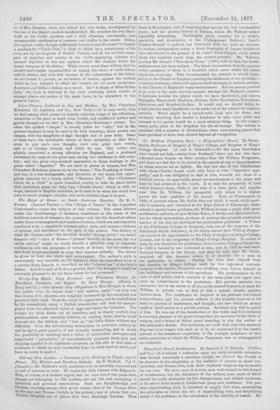Old and New London : a Narrative of its History,
its People, and its Places. 7%e Western and Northern Suburbs. By E. Walford, Vol. V. (Cassell.)—Mr. Walford's work continues to be as carefully executed and as full of interest as ever. He begins his fifth volume with Belgravia. This, of course, is a modern region, but we soon travel into parts that, though not belonging to Old London, are yet old, and abounding in historical and personal associations. Such are Knightsbridge and Chelsea, counting among other great names, that of Sir Thomas More iuhthe past and Themes Carlyle in the present ; and of places that arc, Chelsea Hospital, and of places that were, Ranelagh Gardens, Then
there is Kensington, full of memories that include the last two hundred years ; and the gloomy history of Tyburn, which Mr. Walford makes
especially interesting. Paddington gives occasion for a sketch, narrative and descriptive, of the Underground Railway ; Lord's Cricket-Ground is noticed, but dismissed with too brief an account. In curious juxtaposition comes a short biography of Joanna Southeott (she was buried in the ground of St. John's Wood. Chapel, which stands about two hundred yards from the cricket-ground). Mr. Walford, quoting Mr. Grant's "Travels in Town" (1839), tolls us that the South- cottians were not then extinct. The latest information that the present writer possesses of them is a handbill, which came under his notice about ten years ago. This recommended the faithful to attach them- selves to the Church of England, pending the fulfilment of the promise,— a curious testimony, which will approve itself variously to various persons, to the Church of England's comprehensiveness. But we cannot pretend to go even in the most cursory manner through Mr. Wafford's volume. It includes, besides the places which we have mentioned, and others, Highgate, Hampstead, Hackney, Hoxton, Stoke Newington, Tottenham, Edmonton, and Stratford-le-Bow. It would not, we should think, be a bad plan for small handbooks to be made out of the volume for separate suburbs. There might be a considerable locel sale for them, and certainly anything that moves a Londoner to take some pride and interest in his parish would be a most salutary thing. In this respect every petty place in the kingdom has the advantage. The volume is enriched with a number of illustrations, often representing places that have perished or have been altered beyond all recognition.






































 Previous page
Previous page